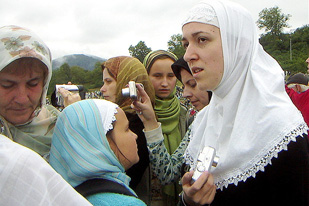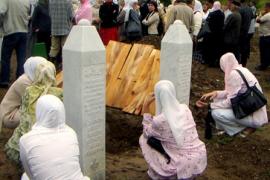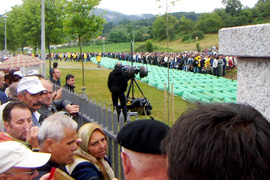Return to Srebrenica
Mourners bury newly identified victims, marking the massacre’s 12th anniversary.

 |
| More than 30,000 people attended the service, during which the names of the 465 victims were read out |
The bodies of hundreds of newly identified victims of the 1995 Srebrenica massacre have been reburied in a ceremony to mark the 12th anniversary of the war-time killings.
More than 30,000 people attended the service, during which the names of the 465 victims were read out by a child.
The remains were identified after being found in the many mass graves around Srebrenica.
More than 8,000 Bosnian Muslim men and boys were killed after being detained by Serbian forces as they stormed the city in July 1995; it is considered the worst mass slaughter in Europe since the second world war.
So far, DNA testing and forensic examinations have led to the identification and reburial for more than 3,000 victims.
They have been laid to rest at a memorial centre in the Srebrenican suburb of Potocari, where a museum has been opened and the names of the victims are engraved on marble blocks.
Jasmina Tesanovic of the international peace network, the Women in Black, attended the ceremony and tells her story to Al Jazeera.
| First person | ||||
|
Why did I expect it to be easier this year? Going to Srebrenica was never easy. It’s called a “high risk business” by the local Serbian police, even in Belgrade.
On the night before the Srebrenica anniversary, we held a commemorative vigil in the Square of the Republic, as has been our ritual for the past 12 years.
Standing soberly in black with lit candles, holding the banner ‘Srebrenica – Not to be Forgotten’, we stood in the city’s largest public square; there was no press coverage because the Serbian press prefers to forget.
We numbered 103 women and were guarded by 100 police officers, almost one-to-one. We were isolated like a political virus from our non-existent audience, though in past years crowds have insulted us and beaten us.
Srebrenica is now a closed issue, according to local officials. After the sentence at The Hague tribunal in May, which declared the Serbian government not guilty of genocide – merely guilty of not preventing it – the Serbian authorities as well as the local silent majority can live in denial with official global approval.
This makes us ‘the crazy women’, the fools who still ride in buses to pay due honours to the 400 fragmentary dead, who today joined 8,000 others killed and missing, all buried in the Srebrenica mass graveyard after being scattered all over the region by their killers.
One woman is burying the bones of her son for the third time, because his body was never found whole.
Among those being reburied today are four victims killed on video by the Scorpion paramilitaries.
We are joined by friends from the Srebrenica Mothers Association, and as we cross the Serbian border through the Republica Srpska, towards a beautiful natural site which is also the horror shrine, the words of a Serbian nationalist come to my mind: “The dead have taken the best land for graves, while we Serbs should take it back for the sheep.”
“The final victims will be the Bosnians”
Only 12 years ago, the valley of Srebrenica had a prosperous factory – this was turned into a UN base during the war and finally used as a prison slaughterhouse during the fall of Srebrenica.
About 8,000 men and boys from the UN safe area were executed in three days in 1995 by the leader Ratko Mladic, while UN troops looked the other way.
Today, that former UN enclave, occupied mostly by women survivors and the graves of their men, is demanding autonomy for Srebrenica within the Republika Srpska.
The victims cannot live together with the killers, especially since those responsible have still not been brought to justice, 12 years after the slaughter took place.
The survivors are also suing the Dutch military who failed to protect them when serving as UN troops there – the same international troops who were recently awarded service medals for bravely staying alive.
My friend Nevzeta says: “As soon as this war started in Bosnia, we all knew: the Serbs and Croats will make some deal with the international community, while the final victims will be the Bosnians.”
In world diplomacy, if you don’t already know who the chosen victim is, then that victim is you.
They didn’t know such things in Srebrenica. They are poor, rural people who sometimes believed in Allah, but mostly in Yugoslavia.
Now Nevzeta is sobbing in front of the monument to the dead of Srebrenica. We set our wreath of flowers there, from Women in Black, Serbia: “Forgive us.”
We are the only bus to come from Serbia. Nobody has come from Republika Srpska, the Serbian enclave in Bosnia.
The ambassador from Serbia to Bosnia is present, along with ambassadors from around the world and one of the Bosnian presidents. Carla del Ponte, the president of the Hague tribunal, is there too.
The Women in Black delegation stands right next to the monument because the people have opened their way for us to be there.
Mothers have come to kiss us. My vision is blurred with tears as the mists descend from the hills above us. The voice of a girl sings in the silence of thousands of mourners. Yes, nature rebels in the places of crime: the crime scene becomes sacred ground.
A young girl has a fit of tears, she is a Bosnian teen in jeans with her head covered with a shawl.
She is carried out of the crowd, shortly before the 400 corpses wrapped in green fabric are carried by their relatives to their graves.
Their names are read out over the loudspeakers, as well as their date of birth. Young people mostly, all men, all Muslims.
The mud of the grave is turning yellow, for this is a fertile land, but the relatives of the dead are waiting for the bodies to be placed in that mud.
“May mother’s tears turn to hope”
One bereaved mother comes up to me and hugs me, saying: “If people will not praise you for what you are doing, God will, I am sure, even if you don’t believe in one.”
I’m not a believer, but I believe in her and her words. If she can manage to live without her sons, husband, brothers, and alongside their killers, and without a penny, while fighting The Hague war tribunal for truth and justice, then I can do my work too.
A fatwa is read out by the preacher: “May mothers’ tears turn into hope,” he says, “and may the killers get the blessing of a punishment.”
A Muslim prayer is allowed for Muslim women too, as a conspicuous exception to the norm, and for all other religions as a double exception. Crime has no religion or nationality.
These were my own people speaking my own language, yet killed by people speaking the language of crime, in my name.
I go to see the big memorial museum, which opened two days ago, this former factory where the dead of Srebrenica were crammed in before being delivered to the slaughter.
This uncanny place features huge broken pipes and ducts along with long-dead machines from the communist regime.
In one corner there are some 50 photos of the dead as well as objects found to help identify them: a pipe, a wallet or a watch.
I remember the piles of empty shoes at Auschwitz, that factory of death that cremated even the bones. Why do the bones matter so much, I wonder?
A weepy rain falls on the just and the unjust alike, turning every one of us into clay figurines, nameless and without a nation.
When the ceremony ends, we move through the surging, anonymous crowds, back to our unremarkable tour bus.
A cathartic feeling creeps onto our bewildered minds as we literally carry the mud of the grave on our shoes. |

